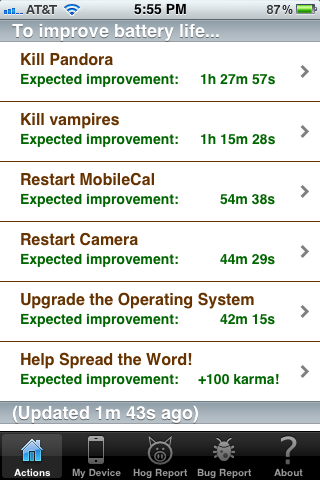Save battery life: Why you need to stay indoors and leave the neighbours' wi-fi alone

The most common complaint about smartphones is battery life - or the lack of it. Although we're getting used to carrying battery boosters and chargers around, a new study [PDF] by the University of Helsinki's Nodes research group has uncovered a few tips that can help you stretch out the life of your phone.
Nodes combined crowdsourced measurements from Carat, a mobile energy diagnostic app, and a new collaborative data analysis method to study the impact of different settings on mobile device battery consumption.
The main findings? A mixture of common sense and practicality: let the automatic settings take care of your phone screen brightness, stay away from weak wi-fi signals, and don't leave your smartphone in the sun.
"Settings, features, and active applications have a significant effect on how much energy a device uses," says Sasu Tarkoma, a University of Helsinki professor and Nodes group member. He gives an example: "Running applications with a smaller CPU load and lowering screen brightness will extend battery life."
A topical way to avoid major battery drain is to keep your phone away from sunlight. A smartphone sitting in the sun, or in hot temperature in general, can experience over 50 percent worse battery life than one in cool conditions indoors. The effect can be the same on a battery that overheats because of heavy use or a fault with the battery.
What's more, avoiding weak wi-fi can make a drastic difference to battery life. When the signal strength drops by one bar, it can increase battery loss by over 13 percent.
Given that the results are based on over 11 million measurements from more than 150,000 Android devices around the world, anyone who cares about extending their phone's battery life would be wise to stay in the shade and leave your neighbour's wi-fi alone this summer.
Almost half of smartphones have energy anomalies
Originally launched in 2012, the Helsinki University co-developed Carat app has been used on over 800,000 iOS and Android devices and has analysed more than 370,000 mobile applications to see if they are energy hogs or have energy bugs.
The results show apps frequently impact battery life. According to the data, eight percent of applications are energy hogs (they use more battery than average applications), and four percent are energy bugs: applications that behave normally for most users but use more energy for a particular user or users.
When studied at the device level, on average 47 percent of Android and iOS smartphones have at least one of these kinds of energy anomaly.
The good news is you don't have to be a researcher to identify them. The free Carat app generates reports on a device's energy use and offers personalised recommendations on how to improve battery life, such how many minutes of extra charge you would gain from killing a specific app. Of course for it to work, you must be comfortable giving up anonymous data (mobile network type, battery temperature, CPU use, and so on) for research purposes.
"The app reveals the energy hogs and bugs in a specific device by comparing the device to other devices. It can also tell how the device and the user compare to other users in terms of energy efficiency," says Helsinki University's Tarkoma.
"People who have used Carat for over 80 days and got recommendations through it, regardless of whether they follow that advice or not, will see their energy use improve on average by 41 percent... Just being aware of energy usage can indirectly affect user behaviour."
The Carat website also lists the most energy-intensive mobile apps based on user numbers and the battery gains from removing them.
The horse behind the Carat
The Carat app is built upon the open source analytics engine Spark and measures device use, battery discharge, system state, and hardware power metrics. This data is sent to the University's servers where statistical values are extracted and combined with other users' data, and then feedback is returned to the devices.
Carat was originally created through collaboration between the University of California, Berkeley and Helsinki University. Its development was later moved over to the Finnish research team, a subset of the larger Nodes group which is led by Tarkoma and postdoctoral researcher Eemil Lagerspetz.
Lagerspetz and Tarkoma co-wrote the Nodes battery consumption study together with fellow Nodes researchers Ella Peltonen and Petteri Nurmi.
The researchers believe the biggest breakthrough of the study has been demonstrating their method of constructing energy models from crowdsourced measurements works. The method is based on the collaborative data analysis concept examined in Lagerspetz's PhD thesis.
"It is a completely new approach for mobile energy profiling and optimisation. The idea of data collection and finding anomalies isn't new, but the focus on mobile devices and energy usage and the creation of a model for identifying hogs and bugs, that hasn't been done before," Tarkoma explains. "We also have a significant dataset. We have built a valuable data bank for research."
The research team claims that, while previous approaches have focused on the effect of a specific system setting or application, the collaborative method can capture the combined effect of multiple factors. This provides an overall picture of the energy state of a mobile device.
Commercial applications
However, studying battery consumption is just the start. Currently the Nodes team is working on applying the collaborative approach to other topics, notably data security and advanced battery diagnostics (that is, how batteries are charged and used).
The Nodes team has already published some results in this field, particularly in relation to whether the set of applications on a mobile device can be used to predict the device's vulnerability to malware. By analysing how different applications correlate with particular malware, the researchers found out that the application set can be used as an indicator (or a 'weak signal') of a malware infection risk.While not an accurate indicator of infection itself, the application set can reveal which devices are most at risk and need more extensive analysis.
"[Off the back of this] we have developed a malware prognosis application called MDoctor that tells users about the weak signal and offers a kind of 'radar view' to their device's security," Tarkoma says. "Many companies have a 'bring your own device' [BYOD] policy. In those cases, it is important to get an overall view of these devices' security state and our system can help with that."
While this is one potential commercial application of their analysis method, Tarkoma and Lagerspetz have already taken its evolution a step further. In 2014 they founded Seneqo, a startup focused on automatic anomaly detection and large-scale data analysis. It already has pilot customers.
Consumers have believed for some time that improving smartphone battery life improves almost anything. Now this research shows that not only are they right, but they might get that improvement sooner than they hoped.
Read more on battery life